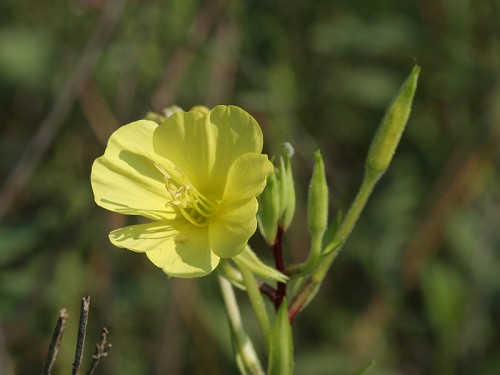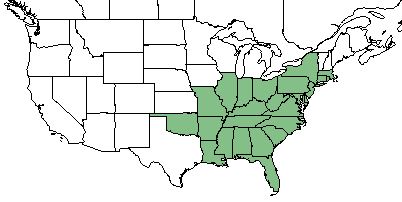Difference between revisions of "Oenothera fruticosa"
Krobertson (talk | contribs) (→Ecology) |
|||
| Line 36: | Line 36: | ||
''O. fruticosa'' flowers from May through August,<ref name="Weakley 2015"/><ref name="PanFlora">Nelson G. (20 December 2017) PanFlora. Retrieved from gilnelson.com/PanFlora/</ref> peaking in April and May.<ref name="PanFlora"/> It produces four-petaled golden yellow flowers that average 2 in (5.1 cm) in diameter.<ref name="Ladybird"/> | ''O. fruticosa'' flowers from May through August,<ref name="Weakley 2015"/><ref name="PanFlora">Nelson G. (20 December 2017) PanFlora. Retrieved from gilnelson.com/PanFlora/</ref> peaking in April and May.<ref name="PanFlora"/> It produces four-petaled golden yellow flowers that average 2 in (5.1 cm) in diameter.<ref name="Ladybird"/> | ||
| − | ===Seed dispersal=== | + | <!--===Seed dispersal===--> |
| − | |||
===Seed bank and germination=== | ===Seed bank and germination=== | ||
| − | ''O. fruticosa'' requires at least 3 weeks of vernalization (cooling of seeds during germination) to reduce the time to flowering and produce a high percentage of flowering. Plant height would peak at 40-50 cm (15.7-19.7 in) after 9 weeks of vernalization and a 14 hour photoperiod. Increasing photoperiods from 10-16 hours also caused decreases in the time until flowering, the number of new nodes, number of flowers, and the number of lateral shoots. Temperatures from 15-30 °C (59-86 °F) were indirectly proportional to the number of flowers, flower diameter, and plant height.<ref name="Clough et al 2001">Clough E. A., Cameron A. C., Heins R. D., and Carlson W. H. (2001). Growth and development of ''Oenothera fruticosa'' is influenced by vernalization duration, photoperiod, forcing temperature, and plant growth regulators. Journal of the American Society of Horticulture Science 126(3):269-274.</ref> | + | In Illinois farmed and unfarmed baldcypress swamps, seeds of ''O. fruticosa'' averaged densities of 99 and 166 seeds m<sup>-2</sup>, respectively.<ref name="Middleton 2003">Middleton B. A. (2003). Soil seed banks and the potential restoration of forested wetlands after farming. Journal of Applied Ecology 40:1025-1034.</ref> ''O. fruticosa'' requires at least 3 weeks of vernalization (cooling of seeds during germination) to reduce the time to flowering and produce a high percentage of flowering. Plant height would peak at 40-50 cm (15.7-19.7 in) after 9 weeks of vernalization and a 14 hour photoperiod. Increasing photoperiods from 10-16 hours also caused decreases in the time until flowering, the number of new nodes, number of flowers, and the number of lateral shoots. Temperatures from 15-30 °C (59-86 °F) were indirectly proportional to the number of flowers, flower diameter, and plant height.<ref name="Clough et al 2001">Clough E. A., Cameron A. C., Heins R. D., and Carlson W. H. (2001). Growth and development of ''Oenothera fruticosa'' is influenced by vernalization duration, photoperiod, forcing temperature, and plant growth regulators. Journal of the American Society of Horticulture Science 126(3):269-274.</ref> |
<!--===Fire ecology===--> <!--Fire tolerance, fire dependence, adaptive fire responses--> | <!--===Fire ecology===--> <!--Fire tolerance, fire dependence, adaptive fire responses--> | ||
Revision as of 16:24, 22 January 2018
| Oenothera fruticosa | |
|---|---|

| |
| Photo by John Gwaltney at Southeastern Flora.com | |
| Scientific classification | |
| Kingdom: | Plantae |
| Division: | Magnoliophyta - Flowering plants |
| Class: | Magnoliopsida - Dicots |
| Order: | Myrtales |
| Family: | Onagraceae |
| Genus: | Oenothera |
| Species: | O. fruticosa |
| Binomial name | |
| Oenothera fruticosa L. | |

| |
| Natural range of Oenothera fruticosa from USDA NRCS Plants Database. | |
Common Name(s): narrowleaf evening primrose,[1][2] southern sundrops, small-fruited sundrops, flatrock sundrops[3]
Contents
[hide]Taxonomic Notes
Subspecies: O. fruticosa ssp. fruticosa; O. fruticosa ssp. tetragona[1]
Varieties: O. fruticosa var. fruticosa; O. fruticosa var. O. fruticosa var. microcarpa; O. fruticosa var. subglobosa; O. fruticosa var. unguiculata[3]
Description
Oenothera fruticosa is a dioecious perennial forb/herb[1] that reaches 18-24 in (0.46-0.61 m) in height.[2] It can be found as a diffusely clustered system of unbranched stems containing lance shaped leaves of 2-3 in (5.1-7.6 cm) in length. During the winter months in its southern range, O. fruticosa appears as a reddish-purple basal rosette. This species requires sunlight and well-drained soils, but is also tolerant of brackish and lime soils.[2]
Distribution
O. fruticosa can be found in from Maine south to Florida and westward to Michigan, Missouri, Oklahoma, and Louisiana.[1][3] It can also be found in parts of Manitoba, Ontario, and Quebec provinces in Canada.[1]
Ecology
Habitat
This species is found in dry forests and woodlands, glades, rock outcrops, boggy depressions, granite flatrocks and domes, sandhills, and moist to wet loamy savannas.[3]
Phenology
O. fruticosa flowers from May through August,[3][4] peaking in April and May.[4] It produces four-petaled golden yellow flowers that average 2 in (5.1 cm) in diameter.[2]
Seed bank and germination
In Illinois farmed and unfarmed baldcypress swamps, seeds of O. fruticosa averaged densities of 99 and 166 seeds m-2, respectively.[5] O. fruticosa requires at least 3 weeks of vernalization (cooling of seeds during germination) to reduce the time to flowering and produce a high percentage of flowering. Plant height would peak at 40-50 cm (15.7-19.7 in) after 9 weeks of vernalization and a 14 hour photoperiod. Increasing photoperiods from 10-16 hours also caused decreases in the time until flowering, the number of new nodes, number of flowers, and the number of lateral shoots. Temperatures from 15-30 °C (59-86 °F) were indirectly proportional to the number of flowers, flower diameter, and plant height.[6]
Pollination
It is known to attract birds, hummingbirds, and a large number of native bees.[2] Honeybees deposit, on average, 193-223 grains of pollen per visit to O. fruticosa.[7][8] Soldier beetles also pollinate O. fruticosa, leaving 114 grains of pollen per visit.[8] The number of seeds set is proportional to the number of pollen grains which asymptotes around 150 seeds set and 400 pollen grains.[7]
Use by animals
Oenothera fruticosa composes 2-5% of the diet of large mammals and 5-10% of the diet for terrestrial birds.[1]
Conservation and Management
Cultivation and restoration
Photo Gallery
References and notes
- ↑ Jump up to: 1.0 1.1 1.2 1.3 1.4 1.5 USDA, NRCS. (2016). The PLANTS Database (http://plants.usda.gov, 20 December 2017). National Plant Data Team, Greensboro, NC 27401-4901 USA.
- ↑ Jump up to: 2.0 2.1 2.2 2.3 2.4 Plant database: ‘’Oenothera fruticosa’’. (20 December 2017).Lady Bird Johnson Wildflower Center. URL: https://www.wildflower.org/plants/result.php?id_plant=OEFR
- ↑ Jump up to: 3.0 3.1 3.2 3.3 3.4 Weakley A. S.(2015). Flora of the Southern and Mid-Atlantic States. Chapel Hill, NC: University of North Carolina Herbarium.
- ↑ Jump up to: 4.0 4.1 Nelson G. (20 December 2017) PanFlora. Retrieved from gilnelson.com/PanFlora/
- Jump up ↑ Middleton B. A. (2003). Soil seed banks and the potential restoration of forested wetlands after farming. Journal of Applied Ecology 40:1025-1034.
- Jump up ↑ Clough E. A., Cameron A. C., Heins R. D., and Carlson W. H. (2001). Growth and development of Oenothera fruticosa is influenced by vernalization duration, photoperiod, forcing temperature, and plant growth regulators. Journal of the American Society of Horticulture Science 126(3):269-274.
- ↑ Jump up to: 7.0 7.1 Silander J. A. and Primack R. B. (1978). Pollination intensity and seed set in the evening primrose (Oenothera fruticose). The American Midland Naturalist 100(1):213-216.
- ↑ Jump up to: 8.0 8.1 Primack R. B. and Silander, Jr. J. A. (1975). Measuring the relative importance of different pollinators to plants. Nature 255(5504):143-144.